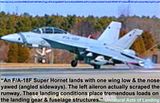For 'Heathrow Hairy': "...Like Courtney I'm just surprised that there is so little apparent research into such an important and obvious issue........ seems to be a "Suck it and see" approach". Yes there is a lot of research, testing and redesign with further testing as indicated in the material below.
A Study of the Aircraft Arresting-Hook Bounce Problem By J. THOMLINSON, Ph.D. May
1954
http://naca.central.cranfield.ac.uk/...rc/rm/2980.pdf
"
SUMMARY: The kinematics of an arresting-hook unit are studied in order to determine, within the limits of the assumption of a perfectly rigid hook unit, the damper force necessary to control hook bounce. The necessity for a smooth deck and the desirability of small trail angle for the hook unit are demonstrated from several aspects. The design requirements for a hook damper unit are discussed in all their functional aspects and methods are given for determining the up-swing motion of an arresting hook unit immediately following engagement of an arresting wire. The behaviour of arresting wires after being depressed by the passage of aircraft wheels is also outlined...."
__________________
A Brief History of Tailhook Design 16 Dec 2011 by Tommy H. Thomason
http://thanlont.blagspot.com/2011/12...ok-design.html [change 'blag']
___________________________
How hook arrangements change - First Skyhawk mockup with 'yoked' hook design:
http://a4skyhawk.org/sites/a4skyhawk...y/137812m1.jpg
________________________
Som USN MilSpec re 'Arrested Landing Gear':
http://www.everyspec.com/MIL-SPECS/M...17C.018182.PDF
__________________________
Unnatural Acts of Landing Patuxent River Naval Air Museum Association
The Kneeboard Mag'n Spring 2012
http://api.ning.com/files/8OBnZkm85r...Spring2012.pdf
-“For most people, the idea of flight testing means seeing how fast an airplane can go or how quickly it can maneuver. While answering these questions may be part of a flight test program, there is more to flight testing than speed and agility. Navy carrier aircraft must also withstand the stressful loads of repeated arrested landings (traps) that can exceed 6 Gs on the aircraft.
The landing gear must:
- Survive thousands of landing shocks
- Reduce the loads reaching the aircraft structures and crew
- Allow the pilot to stay in control of the aircraft’s behavior
Ground Loads Testing shows that an aircraft structure can withstand carrier operations at maximum takeoff and landing weights. Normal landings at these conditions are no problem. But testing must also show that an aircraft can absorb these loads when:
- Its sink rate (how fast it descends) is high (as much as 26 feet per second!)
- Its wings are not level when it lands
- Its tailhook catches an arresting cable to the side of the center line
- The carrier deck pitches and heaves...
...During Super Hornet development, Ground Loads Testing required 125 test flights, 370 catapult launches, 471 traps, & 3 years to complete. Incidents included blown tires & various airplane parts (other than the wheels & tailhook) hitting the deck."
&
"What Is a “High Trap”? Normally when an aircraft “traps” (lands on a carrier), its wheels contact the deck (or the runway during practice landings) just before the tailhook snags the arresting cable. But sometimes the tailhook will engage the arresting cable before the wheels touch down. This is known as an “inflight engagement” or “high trap.” Both the aircraft and the pilot are slammed down hard as the aircraft is suddenly snatched from the air. These are not fun landings.”
Click thumbnail for an unnatural act:
